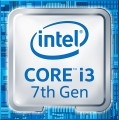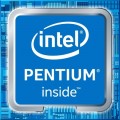Series
The series to which the processor belongs.
A series usually combines chips that are similar in general level, characteristics, features and purpose — for example, low-cost processors with low power consumption, mid-range models with advanced graphics capabilities, etc. It is most convenient to start choosing a processor by determining the series that is optimal for you fit; however, it is worth considering that chips of the same series may belong to different generations.
Here are the most popular series of processors from Intel:
—
Celeron. Low-cost-level processors, the most simple and inexpensive consumer-level desktop chips from Intel, with the appropriate characteristics. They can combine a CPU with an integrated graphics module.
—
Pentium. A series of low-cost desktop processors from Intel, somewhat more advanced than the Celeron.
—
Core i3. A series of entry-level and mid-level processors, the most budgetary series in the Core ix family. They are based on a dual-core architecture, have a third-level cache and an integrated graphics processor.
—
Core i5. A series of mid-range processors, both in general and in the Core ix family. The architecture is dual or quad-core, have a third-level cache, many models are also equipped with an integrated graphics chip.
—
...Core i7. A series of performant processors; before the introduction of the i9 line in May 2017, they were the most advanced in the Core ix family. They have at least 4 cores(up to 8 in top solutions), a volumetric level 3 cache and integrated graphics.
— Core i9. High performance desktop processors introduced in 2017; the most advanced Core ix series and the most powerful line of desktop CPUs at the time of release. They have from 10 cores (from 6 in mobile versions).
— Xeon. A series of high-performance processors designed primarily for servers. Well suited for multiprocessor systems. The number of cores is 2, 4 or 6, many models have a third-level cache.
AMD's most popular CPU series these days include Ryzen 3, Ryzen 5, Ryzen 7, Ryzen 9, Ryzen Threadripper, EPYC.
— A series. A series of so-called hybrid processors from AMD, also called APU — Accelerated Processing Unit. They are mainly high-end solutions with advanced integrated graphics, the capabilities of which in some models are comparable to discrete graphics cards. In particular, for the latest A-Series processors, the possibility of full-fledged work with many popular online games at maximum settings is claimed.
— EPIC. A series of professional processors from AMD, designed primarily for servers; are positioned, in particular, as solutions optimized for use in cloud services. Built on the Zen microarchitecture, just like desktop Ryzen (see below).
— FX. A family of high-end performance processors from AMD, the world's first series to introduce an octa-core processor for PCs. However, there are relatively modest quad-core ones. Another feature is liquid cooling, which is included in the standard delivery of some models: classic air cooling is not enough given the high power and the corresponding TDP (see below).
— AMD Fusion. The entire Fusion processor family was originally created as integrated graphics devices, combining a central processing unit and a graphics card in one chip; such chips are called APU — Accelerated Processing Unit, and their graphics performance is often comparable to inexpensive discrete graphics cards. Modern Fusion processors are marked with the letter A and an even number — from A4 to A12; the higher the number, the more advanced the series is.
— Athlon. The Athlon marking itself is used in many processor families from AMD, including those that are completely obsolete. Nowadays, this name can mean both Athlon X4 and "regular" Athlons with the code name specified — usually Bristol Ridge or Raven Ridge. All these CPUs are designed mainly for consumer-level systems. At the same time, X4 chips were released in 2015 and are positioned as relatively inexpensive and at the same time performant solutions for the FM + socket. Athlon Bristol Ridge processors appeared in 2016 and became the latest series of "athlons" based on the Excavator microarchitecture (28-nm process technology). The next generation, Raven Ridge, used the Zen microarchitecture, which introduced a number of key improvements — in particular, a 14nm process technology and multi-threading support. Both of these series belong to the middle level.
— Ryzen 3. The third series of processors from AMD built on the Zen microarchitecture (after Ryzen 7 and Ryzen 5). The first chips of this series were released in the summer of 2017 and became the most low-cost solutions among all Ryzen. They are produced using the same technologies as the older series, however, half of the computing cores are deactivated in Ryzen 3. Nevertheless, this line includes quite performant devices, including those designed for gaming configurations and workstations.
— Ryzen 5. A series of processors from AMD, built on the Zen microarchitecture. The second series on this architecture, released in April 2017 as a more affordable alternative to Ryzen 7 chips. Ryzen 5 chips have slightly more modest performance characteristics (in particular, a lower clock speed and, in some models, L3 cache size). Otherwise, they are completely similar to the "sevens" and are also positioned as high-performance chips for gaming and workstations. See "Ryzen 7" below for details.
— Ryzen 7. AMD's first series of processors based on the Zen microarchitecture. It was introduced in March 2017. In general, Ryzen chips (all series) are promoted as high-end solutions for gamers, developers, graphic designers and video editors. One of the main differences between Zen and previous microarchitectures was the use of simultaneous multithreading (see "SMT (multithreading)"), due to which the number of operations per clock was significantly increased at the same clock frequency. In addition, each core received its own floating point unit, the speed of the first level cache has increased, and the L3 cache in Ryzen 7 is nominally 16 MB.
— Ryzen 9. A series introduced in 2019 with the release of third-generation Matisse chips based on the Zen microarchitecture. Like all Ryzen, it is intended primarily for high-performance gaming and workstations, gaming systems and PC enthusiasts; at the same time, this series became the top among all “ryzens”, displacing Ryzen 7 from this position. For example, the first Ryzen 9 models had 12 cores and 24 threads, in later ones this number was increased to 16/32, respectively.
— Ryzen Threadripper. AMD's High-Performance Gaming and Creativity Series: Threadripper chips are specifically designed for high-performance gaming systems and workstations, according to manufacturers. They have 8 cores and support multithreading.
In addition to the series, modern processors are also divided into generations, according to the release time. At the same time, one generation includes several series, and one series can be produced within several generations. See "Code Name" for more on this.Clock speed
The number of cycles per second that the processor produces in its normal operating mode. A clock is a single electrical impulse used to process data and synchronize the processor with the rest of the computer system. Different operations may require fractions of a clock or several clocks, but anyway, the clock frequency is one of the main parameters characterizing the performance and speed of the processor — all other things being equal, a processor with a higher clock frequency will work faster and better cope with significant loads. At the same time, it should be taken into account that the actual performance of the chip is determined not only by the clock frequency, but also by a number of other characteristics — from the series and architecture (see the relevant paragraphs) to the number of cores and support for special instructions. So it makes sense to compare by clock frequency only chips with similar characteristics belonging to the same series and generation.
IGP
Model of the integrated video core installed in the processor. See "Integrated Graphics" for details on the core itself. And knowing the name of the graphics chip model, you can find its detailed characteristics and clarify the performance of the processor when working with video.
In terms of specific models, Intel processors use
HD Graphics, specifically
510,
530,
610,
630 and
UHD Graphics with models
610,
630,
730,
750,
770. AMD chips, in turn, can carry
Radeon Graphics,
Radeon R5 series,
Radeon R7 series, and
Radeon RX Vega graphics cards.
At the same time,
processors without a graphics core are appropriate for purchase if you plan to fully assemble a PC with a graphics card. In this case, overpaying for a
processor with a graphics core does not make sense.
TDP
The amount of heat generated by the processor during normal operation. This parameter determines the requirements for the cooling system necessary for the normal operation of the processor, therefore it is sometimes called TDP — thermal design power, literally “thermal (cooling) system power”. Simply put, if the processor has a heat dissipation of 60 W, it needs a cooling system that can remove at least this amount of heat. Accordingly, the lower the TDP, the lower the requirements for the cooling system.
Low TDP values(up to 50 W) are especially critical for PCs that do not have the ability to install powerful cooling systems — in particular, systems in compact cases where a powerful cooler simply does not fit.
Instruction
Support by the processor of various sets of additional commands. These can be instructions that optimize the operation of the processor as a whole or with applications of a certain type (for example, multimedia, or 64-bit), prevent certain types of viruses from running on the computer, etc. Each manufacturer has its own assortment of instructions for CPUs.
Multiplier
The coefficient on the basis of which the value of the processor clock frequency is displayed. The latter is calculated by multiplying the multiplier by the system bus frequency (see System bus frequency). For example, with a system bus frequency of 533 MHz and a multiplier of 4, the processor clock speed will be approximately 2.1 GHz.
Passmark CPU Mark
The result shown by the processor in the Passmark CPU Mark test.
Passmark CPU Mark is a comprehensive test that checks not only the gaming capabilities of the CPU, but also its performance in other modes, based on which it displays the overall score; this score can be used to fairly reliably evaluate the processor as a whole.
Geekbench 4
The result shown by the processor in the test (benchmark) Geekbench 4.
Geekbench 4 is a comprehensive cross-platform test that allows, among other things, to determine the efficiency of the processor in various modes. At the same time, according to the developers, the verification modes are as close as possible to various real tasks that the processor has to solve. The result is indicated in points: the more points — the more powerful the CPU, while the difference in numbers corresponds to the actual difference in performance ("twice the result — twice the power").
Note that the benchmark in Geekbench 4 is the Intel Core i7-6600U processor with a clock frequency of 2.6 GHz. Its power is estimated at 4000 points, and the performance of other tested CPUs is already compared with it.
Cinebench R15
The result shown by the processor in the test (benchmark) Cinebench R15.
Cinebench is a test designed to test the capabilities of the processor and graphics card. The creator of this benchmark, Maxon, is also known as the developer of the Cinema 4D 3D editor; this determined the features of testing. So, in addition to purely mathematical tasks, when using Cinebench R15, the processor is loaded with processing high-quality three-dimensional graphics. Another interesting feature is the extensive support for multithreading — the test allows you to fully check the power of chips that process up to 256 threads at a time.
Traditionally, for CPU benchmarks, the test results are indicated in points (more precisely, points — PTS). The more points scored by the CPU, the higher its performance.

